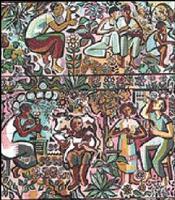
Norman Grindley
A section of Claude Rahir's mural at the University of the West Indies.Michael Robinson, Staff Reporter
Ever since early man painted cave walls with animals and hunting scenes, murals have played a part in our culture.
At times painstakingly applied, cave paintings were an interface that allowed Palaeolithic man to commune with the magical forces governing his reality. By creating a successful hunt on the walls of his dwelling, success would be ensured in the consequent endeavour.
Through time, murals images created for or on walls or ceilings remained a mode through which artists could express themselves in a strong way. From the cave paintings of 15,000 BC to the funerary art of the Egyptians to the billboards of today, there is an evident consciousness of the power of the mural as medium.
Painting is not the only province of murals, sculptors also produce pieces for wall space known as mural sculpture. 'Rainbow Serpent' (1975), by Edna Manley, is one such example.
Applying paint directly to the wall produces a far less durable mural than does the fresco technique. Fresco, which means 'fresh' in Italian, came to the fore during the Renaissance, with works like Michelangelo's Sistine Chapel ceiling and DaVinci's Last Supper among the more famous.
The technique has several variations. The most durable, buon or 'pure' fresco, involves the laying of a fresh wet layer of plaster to which pigments are applied directly. The particles of pigment become chemically bonded to the wall itself when the plaster dries. Due to the nature of this technique, however, only small areas can be worked on at a time as the plaster needs to be wet to receive the pigment.
Because the chemical process is irreversible, restoration of the mural can only be achieved by applying a new layer of plaster, effectively painting over the old one.
The visual and psychological impact of a mural are undeniable. It is disappointing, given the rich visual legacy of our ancestry, to see the mural being largely ignored as a catalyst for social change at a time when such change is exactly what the country needs.
Arguably the most ambitious mural to be found in the island, the mural at UWI's Assembly Hall in Mona stands as a testimony to peace and love between nations.
Completed in 1979 for the International Year of the Child, the painting was a gift to the University of the West Indies by Claude Rahir, a Belgian. The travelling muralist depicted each of the university's eight faculties, as well as children at work and play. The existence of the piece is a lasting sign of inter-nation co-operation.
Mr. Rahir had the right idea.
'Painting it Right' is a collaboration Chichibud Limited, students from The Edna Manley College and a team of young artists from inner-city areas. The project is a forum for positive messages from the youth of the Kingston's inner cities and has produced several murals over the past year for basic schools and hospitals.
This project is a good sign, and shows how the mural can positively affect a community as an activity and as a finished product.
The mural is unique in its accessibility and its potential for strength of impact. For its creators, it can be a challenging and liberating experience. It teaches skills which might eventually feed a family, or become the medium of choice for Jamaica's next Edna Manley.
Viewers also benefit as experiencing a piece of art has been proven to lower blood pressure as well stimulate creativity.
Come to think of it, the road to world peace may very well be one flanked with murals.

